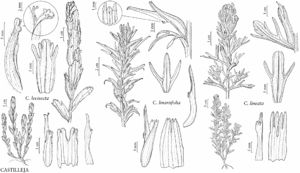Castilleja linariifolia
Prodr. 10: 532. 1846.
Herbs, perennial, 1.8–10 (–20) dm; from a woody caudex; with a taproot or branching roots. Stems few-to-many, ascending to erect, much-branched, glabrous proximally, hairy distally, sometimes glabrous or hairy throughout, hairs sparse, sometimes dense, spreading to slightly retrorse, short to long, ± stiff, eglandular. Leaves ± yellow to gray-green, sometimes becoming ± purple, linear to narrowly lanceolate, (1–) 2–10 cm, not fleshy, rarely ± thickened and fleshy, margins plane, involute, 0–3 (–5) -lobed, apex acute or acuminate; lobes spreading, linear, apex acute to acuminate. Inflorescences 4–20 × 2–7.5 cm; bracts red to red-orange throughout, sometimes pale green, yellow, magenta, pink-purple, or white throughout, or proximally pale greenish to straw colored, distally colored as above, lanceolate to narrowly lanceolate or narrowly oblong, 3 (–5) -lobed; lobes spreading to ascending, narrowly lanceolate to linear, shorter than central lobe, arising in proximal 1/3, apex obtuse to acuminate. Calyces proximally greenish, whitish, or yellowish, distally colored as bracts, 18–30 (–35) mm; abaxial clefts 10–20 (–22) mm, adaxial 2–6 (–12) mm, abaxial ca. 70% of calyx length, adaxial ca. 20–25% of calyx length, deeper than laterals, lateral 1.5–5 (–6) mm, 12–17% of calyx length; lobes curved slightly toward adaxial side, narrowly oblong to narrowly lanceolate, apex acute. Corollas often slightly curved, 25–45 mm; tube 11–22 (–25) mm; beak exserted, longer than calyx lobes, usually projecting through abaxial cleft; beak adaxially yellow-green or green, 9–21 (–24) mm; abaxial lip deep green, reduced, often visible in exserted sideways through abaxial calyx cleft, 0.5–3 mm, 10–15% as long as beak; teeth incurved, green or whitish, 5–2 (–3) mm. 2n = 24, 48.
Phenology: Flowering Apr–Oct.
Habitat: Sagebrush steppes, grasslands, dry rocky slopes and flats, open forests, talus, lowlands to montane, occasionally subalpine.
Elevation: 600–3400 m.
Distribution
Ariz., Calif., Colo., Idaho, Mont., Nev., N.Mex., Oreg., Utah, Wyo.
Discussion
Castilleja linariifolia is widespread in the western United States and is important to Native Americans as a source of dyes and for medicinal and ceremonial purposes (D. E. Moerman 1998). It is the state flower of Wyoming. Castilleja linariifolia is closely associated with, and undoubtedly parasitic on, the roots of sagebrush, Artemisia tridentata. The bracts are usually red to red-orange, with uncommon yellow-bracted variants. On the eastern slope of the Sierra Nevada in California, most populations have pink-purple to magenta bracts, and at least one population has almost pure white bracts. Plants associated with hot springs in the Ash Meadows area of Nye County, Nevada, are unusually tall and have somewhat fleshy leaves. Castilleja linariifolia stems are usually glabrous, but pubescent stems are sporadic across its range. However, in the Mt. Charleston area of the Spring Mountains, in southern Nevada, most plants are pubescent, ranging from an inconspicuous layer to a fairly dense and obvious indument. These plants have been called forma omnipubescens Pennell. Elsewhere, especially in central and northern Arizona, individuals with short-pubescent stems are intermingled with more typical plants. In addition, late-blooming forms associated with hot spring sites in the eastern Mojave Desert are particularly thick-stemmed and vigorous. Hybrids between C. linariifolia and C. scabrida are known from Garfield County, Utah. Castilleja linariifolia is parapatric with the similar C. wootonii in central New Mexico. Castilleja linariifolia is reported to hybridize with C. chromosa, C. flava, and C. miniata. A possible hybrid with C. septentrionalis was named C. ×cognata Greene.
Selected References
None.
Lower Taxa
"dm" is not declared as a valid unit of measurement for this property.
